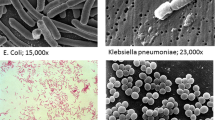Abstract
Purpose
The goal of this study was to determine the rate of surgical site infection and compliance with process measures designed to prevent infection in a defined population of patients undergoing colorectal operations.
Methods
A task-force consisting of surgeons, hospital infection control personnel, anesthesiologists, and nurses was convened to enforce the use of process measures to prevent infections. We monitored antibiotic selection, dosage, timing, redosing and discontinuation, hair removal technique, intraoperative and postoperative body temperature, and perioperative glucose control for 12 months by using electronic medical records. Patients underwent a minimum of 30 days of postoperative follow-up and the attending surgeon diagnosed infections.
Results
Between April 2006 and March 2007, 298 patients underwent abdominal colorectal operations. The overall infection rate was 20 percent for colon procedures and 11 percent for small-bowel procedures. Compliance for most process measures improved from the first to the fourth quarter, and during the final quarter, correct antibiotic dose and hair removal with clippers exceeded 90 percent.
Conclusions
The rate of surgical site infection after colorectal surgery is likely to be higher than that reported in national quality improvement programs. Perfect compliance with performance measures may be difficult to attain.

Similar content being viewed by others
References
Kirkland KB, Briggs JP, Trivette SL, Wilkinson WE, Sexton DJ. The impact of surgical-site infections in the 1990s: attributable mortality, excess length of hospitalization, and extra costs. Infect Control Hosp Epidemiol 1999;20:725–30.
Mangram AJ, Horan TC, Pearson ML, Silver LC, Jarvis WR. Guideline for prevention of surgical site infection, 1999. Centers for disease control and prevention (CDC) Hospital infection control practices advisory committee. Am J Infect Control 1999;27:97–132.
Emori TG, Culver DH, Horan TC, et al. National nosocomial infections surveillance system (NNIS): description of surveillance methods. Am J Infect Control 1991;19:19–35.
Itani KM, Wilson SE, Awad SS, Jensen EH, Finn TS, Abramson MA. Ertapenem versus cefotetan prophylaxis in elective colorectal surgery. N Engl J Med 2006;355:2640–51.
Smith RL, Bohl JK, McElearney ST, et al. Wound infection after elective colorectal resection. Ann Surg 2004;239:599–605.
Fry DE. The surgical infection prevention project: processes, outcomes, and future impact. Surg Infect (Larchmt) 2006;7(Suppl 3):s17–26.
Kurz A, Sessler DI, Lenhardt R. Perioperative normothermia to reduce the incidence of surgical-wound infection and shorten hospitalization. Study of wound infection and temperature group. N Engl J Med 1996;334:1209–15.
van den Berghe G, Wouters P, Weekers F, et al. Intensive insulin therapy in the critically ill patients. N Engl J Med 2001;345:1359–67.
MedQIC. SCIP project information. Accessed on May 15, 2007. Available at: http://www.medqic.org. 2007. Surgical process measures.
Institute for Healthcare Improvement. Protecting 5 million lives from harm. Accessed on May 15, 2007. Available at: http://www.ihi.org. 2007. Surgical process measures.
Lindenauer PK, Remus D, Roman S, et al. Public reporting and pay for performance in hospital quality improvement. N Engl J Med 2007;356:486–96.
Jancin B. Medicare may drop payments for SSI. Gen Surg News 2007;3:1.
Miransky J, Ruo L, Nicoletta S, et al. Impact of a surgeon-trained observer on accuracy of colorectal surgical site infection rates. Dis Colon Rectum 2001;44:1100–5.
Miles AA, Miles EM, Burke J. The value and duration of defense reactions of the skin to the primary lodgement of bacteria. Br J Exp Pathol 1957;38:79–96.
Burke JF. The effective period of preventive antibiotic action in experimental incisions and dermal lesions. Surgery 1961;50:161–8.
Bratzler DW, Houck PM, Richards C, et al. Use of antimicrobial prophylaxis for major surgery: baseline results from the National Surgical Infection Prevention Project. Arch Surg 2005;140:174–82.
Acknowledgments
The authors thank Dr. Charles McCulloch and Chengshi Jin for statistical assistance.
Author information
Authors and Affiliations
Corresponding author
Additional information
Presented at the meeting of The American Society of Colon and Rectal Surgeons, St. Louis, Missouri, June 2 to 6, 2007.
About this article
Cite this article
Wick, E.C., Gibbs, L., Indorf, L.A. et al. Implementation of Quality Measures to Reduce Surgical Site Infection in Colorectal Patients. Dis Colon Rectum 51, 1004–1009 (2008). https://doi.org/10.1007/s10350-007-9142-y
Received:
Revised:
Accepted:
Published:
Issue Date:
DOI: https://doi.org/10.1007/s10350-007-9142-y




